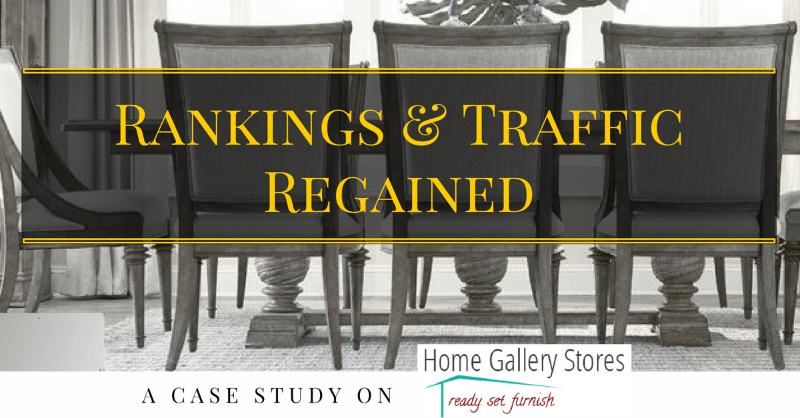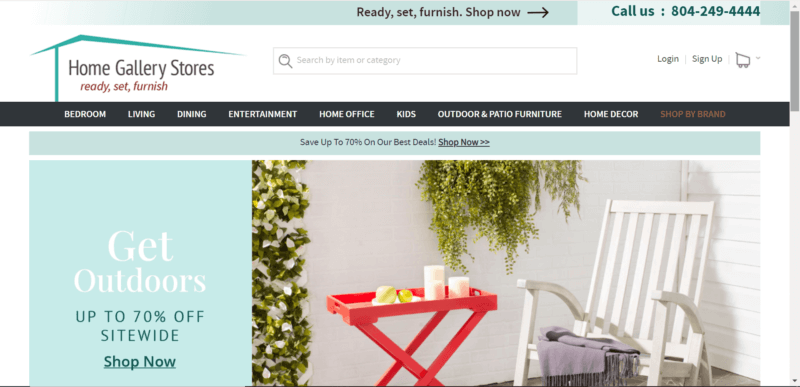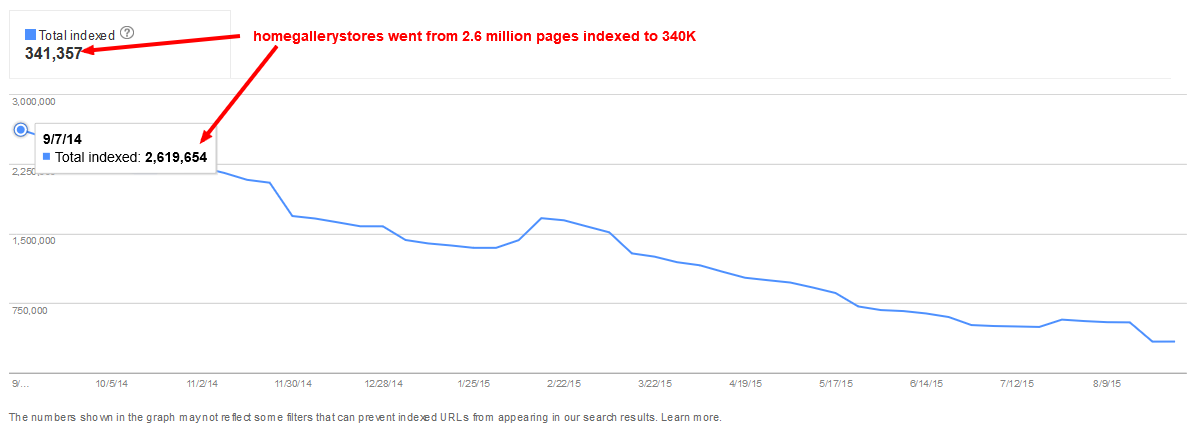Home Gallery Stores Regains Traffic and Rankings as Bruce Clay Deflates Bloated Index
After launching a redesigned website, ecommerce furniture leader HomeGalleryStores.com lost search rankings and Google traffic, which Bruce Clay turned around with technical SEO.

Background
HomeGalleryStores.com reached out to Bruce Clay after the website experienced a sudden, major drop in rankings and traffic.
Before the drop, the national online furniture business consistently ranked on the first page of Google Search results for many of its keywords; however, shortly after the launch of a newly designed website, the company noticed a drop in keyword ranking and a significant reduction in traffic in Google.
Bruce Clay took the challenge, identified the primary cause of the problem as a bloated index, and came up with a strategy to reduce the number of indexed pages and bring back the site’s organic traffic from Google.
Objective: Increase organic traffic from Google by addressing issues related to a bloated index.
Strategy
Diagnosis: HomeGalleryStores.com — an ecommerce business that offers home, office, and outdoor furniture and accessories — launched a newly designed website.
Prior to the launch, the website was performing well with an average of over 7,900 average organic visits per day during the six months prior. During this time many of the client’s top keywords regularly ranked on the first page of Google search results.
For example, nearly 20 percent of their top keywords ranked in the first 10 search results (first page) in Google. But only a few months after the launch of the new site, the website experienced a major drop in rankings and traffic.
Daily sessions dropped to an alarming low of 5,266 average daily sessions during Month 3 after the redesign, and by Month 4, many of the client’s top keywords fell four to 10 positions, pushing a few to the second page of Google search results.
HomeGalleryStores.com experienced over 1,200 net position drops for its tracked key phrases.
Our SEO analysts went to work to uncover the reasons behind the sudden loss in rankings and traffic. First, while examining the client’s account in Google Search Console they noticed an abnormally high number of pages indexed in Google. A snapshot in September revealed 2,619,654 indexed pages.

A Bloated Index
A bloated index has been known to cause traffic and ranking issues for ecommerce websites, especially when those pages being indexed offer no organic SEO value. With so many pages to crawl, search engine robots can get lost, spend too much time crawling the wrong pages, or worse, leave the site before crawling and indexing important landing pages.
While a bloated index was obvious, our SEO analysts dug deeper to find possible reasons for the spike. They examined Google Search Console’s URL Parameters tool report and noticed that Google was processing a high volume of URLS with very similar content.
Identifying Index-Related Issues
Further examination of the extraneous pages revealed a wide range of problems, all of which occurred after the redesign of the website.
Here is a look at the specific indexing-related issues our analysts found and the tactics they came up with to repair the problems.
First, our analysts examined the client’s account in Google’s Search Console URL Parameters tool report. There they noticed that Google was processing a high volume of URLS with very similar content. One reason was that many URLs were in fact near-duplicate pages or similar variations of the same URL.
Another issue involved pages that returned zero products or one product results; these pages are known as soft 404s, and add no organic value to the site.
The third pattern included URLs for product variations that weren’t searched for or that offered little organic benefit. Finally, another group of problematic URLs discovered by our analysts were those with unnecessary URL parameters, such as the sort function or URLs with ratings.
Tactics: In an effort to reduce the number of indexed pages and fix Google’s assessment that the site had too many URLs with similar content and too many low value pages in its index, our analysts came up with four rules (one for each problem):
- In order to spot and get rid of duplicate URLS, our analysts alphabetized all parameters applied from a base URL. This stopped the indexing of multiple variations of faceted search pages. Before this rule, pages with the same filters applied would be indexed if the filters were selected in a different order.
- To tame URLs that returned zero or one product, our analysts added noindex meta tags to these pages, which held them out of Google’s index.
- To get rid of pages that weren’t searched as often or offered little organic benefit, our analysts removed all pages with two or more filters from sitemap files and added noindex meta tags to stop those pages from appearing in Google Search.
- To handle the fourth indexing problem, our analysts removed unnecessary URL parameters completely from the site.
Results
HomeGalleryStores.com started seeing results shortly after Bruce Clay’s strategy and rules were implemented.
Site traffic from Google began to increase, and within three months of the start of the project, HomeGalleryStores.com saw a return to previous traffic levels. Almost 10 percent of the tracked key phrases found themselves on the first page of Google again, and over 1,830 net key phrase positions improved.
After nearly a year of the rules in place, we were able to reduce the bloated index down to 340,000, a 770% decrease in index count.

Summary of Results
- The four rulesets we deployed addressed the site’s indexing issues and reduced its indexed pages count from 2,619,654 to 340,162 year over year.
- Average daily organic visits rose to over 5,300, from the low of 3,641.

- After just two months, 56 priority key phrases improved to top 10 (first page results) in Google, of which a majority were high value/revenue producing manufacturer based terms.
Want to explore how Bruce Clay’s SEO specialists can help your business grow traffic and revenue? Request a conversation or call us directly at (866) 517-1900.



